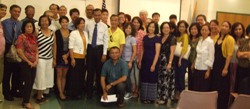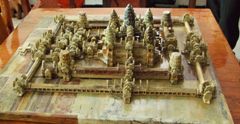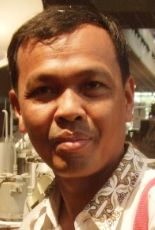The Khmer Reamker overview
According to Judith M. Jacob, more than one Khmer poet composed the epic poem starting in 16th or 17th century. Mrs. Jacob translated the Khmer text from Cambodian Buddhist Institute in Phnom Penh into English, and the translation become a Royal Asiatic Society book published in 2006 by Routledge New York, NY. The poem was composed in verses (though some are incomplete) and in two different compositions, each possibly from a different era. The first composition may have been written significantly prior to the 16th century, based on the writing style and diction.
The first composition consists of the contest for a magic bow, the marriage of Preah Ream and Princess Seda, the banishment of Preah Ream, Princess Seda, and Preah Leak, the abduction of Princess Seda by Ravana (in Khmer, he is known as Krong Reap), the assembling of the monkey troop, the building of a causeway to Langka in an attempt to free Princess Seda, Hanuman’s visit to Princess Seda, the battle to free Princess Seda, and the defeat of Krong Reap. Within this composition, the balance of good and evil, the battle to quell evil, and the preservation of righteousness are shown.
The second composition was written in the 16th or 17th century, and possibly revised in the 19th century. It tells the story of the reunion of Preah Ream and Princess Seda, the question of trust and fidelity after a portrait of Krong Reap is found, the lives of Princess Seda and her sons in exile, and Preah Ream’s quest to regain Princess Seda’s heart.
Reamker remains a fundamental source of Khmer culture, appearing in the classical dance and Royal Ballet repertoire, in the wall paintings and carvings at Angkor Wat, Banteay Srey, and the Royal Palace, and in many operatic dances called Lakhon, including Lakhon Khol (the masked opera dances) and many others. The legends of Preah Ream, Preah Leak, Princess Seda, Hanuman, and Krong Reap are well-known and form the basis for many works of Khmer art and dance.
The epic story may have been part of an oral tradition passed down from one generation to another, and along the way, retold, revised and differed from the original story. In the Khmer ancient times, the story used to be shared at the Buddhist pagoda, where monks copied the story from a palm-leaf to another, often inserting his own account. Consider the classic dance telling the story of Hanuman and Sovanmacha: Hanuman, after an unsuccessful attempt to build a causeway to Langka, lured Sovanmacha into loving him, and she agreed to help him complete the bridge. Although this story is extremely popular in Cambodian culture, it did not appear in the original 16th/17th century Khmer poetry book. It was either added by a word of mouth or created just for a performance.
The epic starts with the exile of Preah Ream, caused by a queen who desired her own son to be king. The aging king, Tusaroth, Preah Ream’s father, had promised his 2nd queen that when the time came, he would crown her son, Prince Bhirut, as king. However, tradition dictated that the eldest son should be crowned king. Thus, King Tusaroth was caught between fidelity to a promise and traditional precedent. Preah Ream observed the intense argument, abdicated the throne and, of his own will, went into the deep jungle, along with Princess Seda and his younger brother, Preah Leak, to become commoners and live their lives as hermits. Prince Bhirut was unaware of the situation because he went to live in his grandparents’ country. Later, he learned of his brother’s exile and refused to be crowned, citing he could not be a legitimate king because the crown belonged to his brother.
Khmer Reamker, which is based on the Indian Ramayana, depicts the protagonist, Preah Ream, as god Narayama or Vishnu taking human form. Narayama is a protector god who quells evil, preserves dharma, and protects righteousness. Throughout the story, all powerful creatures, gods, animals are reduced to submission without violence. When he spoke, he spoke with grace causing other kings to kneel down with respect. Preah Ream and the monkeys represent the force of goodness. Krong Reap and the ogres represent the evil. The battle between the evil and the righteous is the central plot of the epic story. The story also delves into military strategic formation in the battle fields and the way they governed the kingdom, both human and ogre.
Reamker, the Cambodian version of the Ramayana, an English translation by Judith M. Jacob of Royal Asiatic Society, published by Routledge, New York, NY 2006
https://www.cambodiadaily.com/news/the-reamker-cambodias-epic-story-of-magic-and-adventure-is-retold-724/
https://en.wikipedia.org/wiki/Reamker
https://wikivisually.com/wiki/Reamker
http://enacademic.com/dic.nsf/enwiki/334917
https://www.bl.uk/onlinegallery/whatson/exhibitions/ramayana/guide.html








